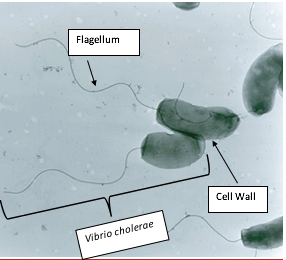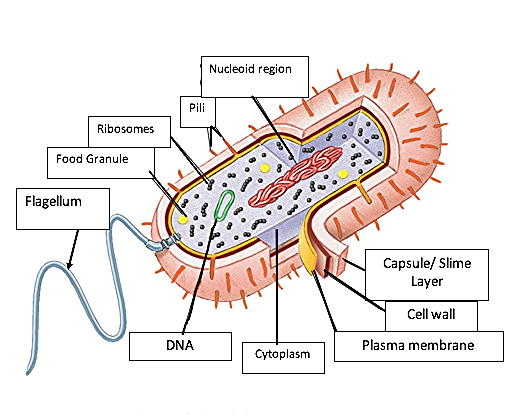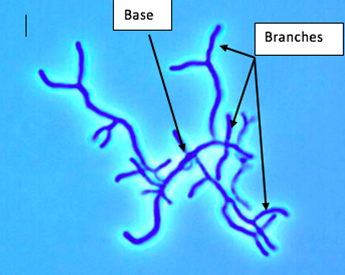DOMAIN • two
•bacteria•
Pathogenic Bacteria:
Common name- Vibrio cholerae
Domain: Bacteria
Phylum: Proteobacteria
Class: Gammaproteobacteria
Order: Vibrionales
Family: Vibronaceaa
Genus: Vibrio
Species: cholerae

Figure 1a: Microscopic Vibrio cholerae bacterium.
Image taken using a scanning electron microscope. In the image above one can see the flagellum and the curved rod shape of the bacteria.

Figure 2a: Drawn diagram of Vibrio cholerae.
One can see all components of the Vibrio cholerae in this image.
Vibrio cholerae is one of many prokaryotic bacteria. Although this is a unicellular bacterium, it acts as if it were multicellular. This organism, like many other pathogenic bacteria, receives its nutrition from its pathogenic relationship with humans. Through binary fission, this bacterium has the ability to reproduce. This is a quick process where the bacterium will divide into two new bacteria [5a].
This bacterium is located in salty waters, coastal rivers and can be spread by feces. This bacterium usually lives in places with bad hygiene and unclean water [1a]. It is a gram negative, curved rod that has oxidase, is non-spore forming [2a], has no nervous system [5a], and is about 1-3 µm by 0.5-0.8 µm [2a]. This bacterium uses a flagellum in order to move [2a]. It can affect both people and animals in the environment it lives in. Vibrio cholerae is known to be associated with the exoskeleton of protozoa, aquatic plants, and water birds [4a]. Once this bacterium has been ingested, either through food or water, it will affect the host in about two to three days [1a]. The first thing to occur is that the bacteria will produce cholera toxin to be released into the body. This toxin will attach to the intestinal walls and will mix with the blood flow. This then will cause an excessive amount of liquids, leading to watery diarrhea, dehydration [3a], vomiting and leg cramps. If left untreated, death may occur within only a couple hours [1a].
Why this belongs in this Domain:
This bacterium belongs in this domain due to a couple reasons. Vibrio cholera has no nucleus and lacks membrane-bound organelles. It is prokaryotic and gram negative. It also is non-photosynthetic and can breathe anaerobically. Its source of motility is flagellum. It is oxidase positive, lives mainly in fresh or saltwater and is rod-shaped. The organisms in domain Eukarya are eukaryotic organisms with a nucleus and membrane bound organelles so this organism does not belong here. This bacteria does not belong in domain Archaea because it gets its energy by being an organotroph.
Beneficial Bacteria:
Common name- Bifidobacterium longum
Domain: Bacteria
Phylum: Actinobacteria
Class: Actinobacteria
Order: Bifidobacteriales
Family: Bifidobacteriaceae
Genus: Bifidobacterium
Species: longum

Figure 3a: Microscopic Image of Bifidobacterium longum.
In the image above one can see a microscopic image of the Bifidobacterium longum. There is a branching part and base part of this bacteria
Bifidobacterium longum is a beneficial, prokaryotic bacterium. It acts as a multicellular organism but is a unicellular organism [9a], it takes the shape of a branched rod, and it has no nervous system [5a]. This bacterium is non-motile, non-spore forming [5a], very adaptive [6a], gram-positive, and anerorobic [7a]. In length, it is 2.26 mb, and can be considered one of the most important beneficial bacteria in humans [8a]. This bacterium reproduces through binary fission, and its source of nutrition is organic electron donors [8a].
This bacteria can do many things, however, its primary activity is preventing the growth of harmful bacteria inside the vagina and gastrointestinal track (GI Track). Once it is ingested, often through dairy products or sauerkraut, it will start to take effect. It boosts the immune system, maintains a healthy Ph level in the intestines by breaking down sugar into a lactic acid, assists with digestion, protects the body from harmful bacteria and may help prevent colon cancer [8a].
Why this belongs in this Domain:
The majority of Bifidobacterium longum's DNA bases are cytosine and guanine bases, and this bacterium is also gram-positive. This means that it falls under the phylum Actinobacteria. This bacterium falls under the order of bifidobacterials because 90% of its composition is bifidobacterium. Since bifidobacteriaceae is the only family that is under the category of bifidobacteriales, which categorizes bacteria, Bifidobacterium longum falls under this family. Bifidobacterium longum is a non-motile, branching, anaerobic bacteria. This is why this bacterium falls under this genus. It falls under the species longum because it is a rod-shaped bacterium. Since this is a bacteria, it would not fall under the domain Archaea. Although the two domains seem similar, they are not the same. Bifidobacterium longum does not belong in Archaea because it contains organelles, and it cannot live in extreme environments. This bacterium would not belong in Eukarya because the bacteria has prokaryotic cells and all the organisms in domain Eukarya have eukaryotic cells.
Answer the following questions based on the paragraphs above.
DM